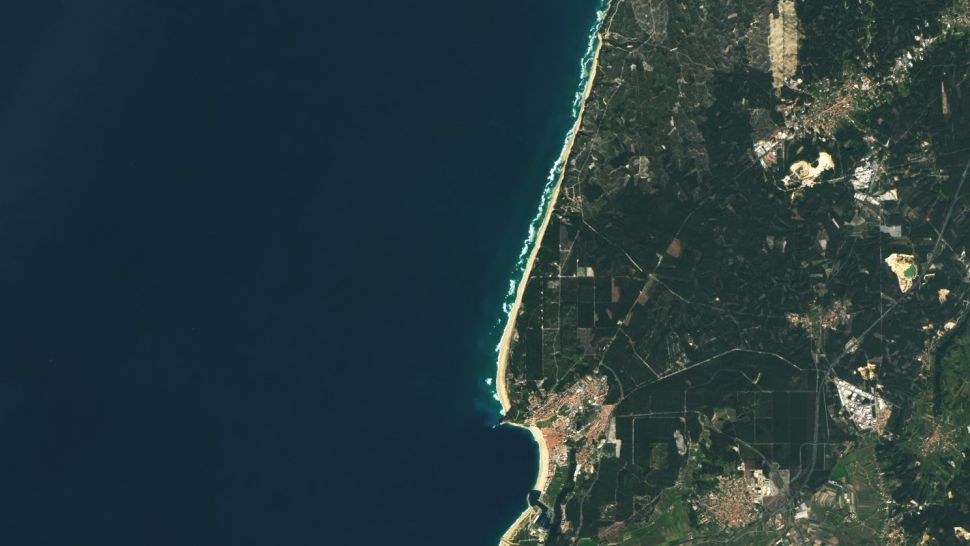Immense power of monster 7-story waves in Portugal spotted in satellite image
An 18-year-old surfer rode a record-breaking 101-foot-wave on the day this image was taken.

NASA has released a stunning image of Portugal’s coastline showing the immense power of massive, seven-story-high waves as they crashed toward the shore. The image, taken in 2020, was captured on the same day that an 18-year-old surfer reportedly rode a record-breaking 101.4-foot-high (30.9 meters) wave in the area.
The photo, which was captured by the Landsat 8 satellite on Oct. 29, 2020, shows a thick band of white foam that was left behind by the massive waves as they broke along the famous North Beach (Praia do Norte) in Nazaré — widely considered to be one of the best locations in the world for big-wave surfing. The image also shows that the ferocious swells ripped up the surrounding seafloor sediment into enormous underwater plumes that stretched around 6.2 miles (10 kilometers) from the shore, according to a NASA Earth Observatory statement.
The waves at Nazaré frequently reach heights of more than 50 feet (15 m) in the winter months due to an underwater canyon less than a kilometer from the coast that channels wave energy. But the waves on Oct. 29 were further enhanced by high winds from the remnants of Hurricane Epsilon, which battered Bermuda and parts of North America in 2020, according to the statement.
Related: Waves of destruction: History's biggest tsunamis
Record-breaking ride
The image was taken on the same day that Portuguese surfer António Laureano headed out to tackle the big waves off Nazaré and rode a potentially record-breaking swell. The surfer, who was just 18 years old at the time, said he was lucky he was out at the right time to catch the massive wave, which was the biggest of the day. "As soon as I started to ride that wave, I realized it was massive," Laureano told Surfer Today in 2020. "But it was only when I kicked out [finished surfing] that I understood what I had accomplished."
After returning home, Laurano sent a video of the wave to researchers at the University of Lisbon in Portugal, who analyzed the swell's size with software that uses the surfer’s height to determine the extent of the wave. "We use the height of the surfer as a scale reference and then look for the crest of the wave [the highest point] and the trough [lowest point]," Miguel Moreira, an oceanographer at the University of Lisbon, told Surfer Today in 2020.
The software indicated that the wave measured 101.4 feet (30.9 m) high. This makes it the largest wave ever surfed by a human, although it is not officially recognized by the World Surf League (WSL) because of the way the researchers analyzed the height of the wave, according to Surfer Today.
Breaking space news, the latest updates on rocket launches, skywatching events and more!
The official largest wave ever surfed was an 80-foot-high (24.4 m) wave, also at Nazaré, ridden by Brazilian surfer Rodrigo Koxa in 2017. This is because the WSL measures the height of waves compared to sea level, which can be done by officials either from the shore or behind the wave as it breaks. Unfortunately, no WSL officials were at Nazaré on the day of Laurano's surf, so the record remains unverified.
Nazaré's monster waves
The reason the waves are so big off the coast of Nazaré is because of the nearby Nazaré Canyon, which is around 143 miles (230 km) long and 3.1 miles (5 km) deep, according to the Portuguese Hydrographic Institute.
When a wave moves through the area, the deeper part of the wave inside the canyon remains the same speed as it was in the open ocean, but the top part of the wave above the canyon slows down. This causes the wave to change direction or bend in a southwesterly direction. However, other waves that do not pass through the canyon remain in a northwesterly direction. When a southwest wave and northwest wave come together at the same time, they combine into a supersized wave, like the one surfed by Laureano, according to the Earth Observatory.
These supersized waves normally only form in the winter months, because during the summer months changes to ocean currents means that incoming waves don’t travel through the canyon in the same way.
Climate change could affect the intensity and frequency of supersized waves at Nazaré in the future, according to research. A study published in the journal Science Advances in June 2020 revealed that extreme wave conditions have already increased by between 5% and 15% due to stronger winds and currents caused by rising ocean temperatures.
The new image was released on Feb. 22 by the NASA Earth Observatory.
Originally published on Live Science.

Harry is a U.K.-based staff writer at Live Science. He studied Marine Biology at the University of Exeter (Penryn campus) and after graduating started his own blog site "Marine Madness," which he continues to run with other ocean enthusiasts. He is also interested in evolution, climate change, robots, space exploration, environmental conservation and anything that's been fossilized. When not at work he can be found watching sci-fi films, playing old Pokemon games or running (probably slower than he'd like).



